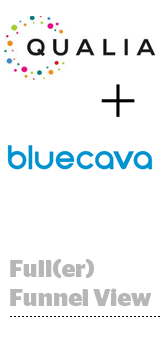 Intent-targeting platform Qualia has merged with early cross-device shop BlueCava, AdExchanger has learned. The move will marry cross-screen data with purchase signals, which the two companies say will strengthen their collective offering.
Intent-targeting platform Qualia has merged with early cross-device shop BlueCava, AdExchanger has learned. The move will marry cross-screen data with purchase signals, which the two companies say will strengthen their collective offering.
BlueCava’s technology – and 40 employees – will fold into the larger Qualia brand. BlueCava chairman and CEO Phil Myers will move into a board role at Qualia, while Kathy Leake, CEO of Qualia and the co-founder of Dstillery (formerly Media6Degrees), will serve as CEO of the combined companies.
Although terms of the deal were not disclosed, BlueCava has raised close to $50 million in several financing rounds.
You might say that in its earliest iteration, BlueCava shared the stage with the “first wave” of cross-device tracking tools, ranging from 41st Parameter, which Experian bought in 2013, to the now defunct Ringleader Digital.
The space has since heated up, as other companies like Oracle, 4INFO, Crosswise, Drawbridge and Tapad, have come out swinging with their own flavor of device graph.
BlueCava initially focused on creating device IDs using statistical or “probabilistic” algorithms, which it could map back to cookies or cross-reference with audiences via third-party ad exchanges.
“We pivoted in 2013 to take what was primarily device identification technology and marry it with real-time association capabilities,” Myers said.
That “association” means showing brands and agencies different degrees of correlations between devices.
“You’re not getting a lot of false positives in our device graph,” Myers claimed. “We’re not identifying a device until we see multiple signals and can correlate it as the same device.”
Leake characterized BlueCava’s lack of reliance on any one data set or signal as one driver for the merger.
For instance, too much reliance on IP-based correlations might return data ascribing 200 devices to a single individual, when realistically, the average device count is only 2.5 per person.
Another factor: more access to location-based data, which, when married with intent signals, could theoretically improve the view of offline-to-online conversion.
Beyond knowing whether someone’s in-market for a car based on whether they test-drove an automobile at a dealership, “we’re adding location coordinates into our data sets to be used for attribution,” Leake said.
Qualia, once known as social ad net LocalResponse, ingests data from myriad sources, including social platforms and third-party commerce and price comparison apps.
“We had a good idea of intent and what a consumer was in-market for previously, but this will help us close the loop and know, with greater accuracy, where they converted,” Leake explained.
Of course, from an advertiser’s perspective, that’s the holy grail. In the past, there was no definitive way of knowing whether a mobile impression impacted a conversion on the desktop. Even with the best attribution models, guesswork was a big part of the process.
Google and Facebook have each developed products aimed at closing the loop in cross-device measurement, but Leake doesn’t foresee a space void of independent probabilistic providers despite those platforms’ deterministic prowess.
“Brands want to own their own data and build their own view of what their audience looks like cross-platform,” Leake added. “At the root of it, this is about open versus closed ecosystems. I would agree with the industry’s take, and that’s the fact that you absolutely need both – deterministic for accuracy and probabilistic for scale.”












